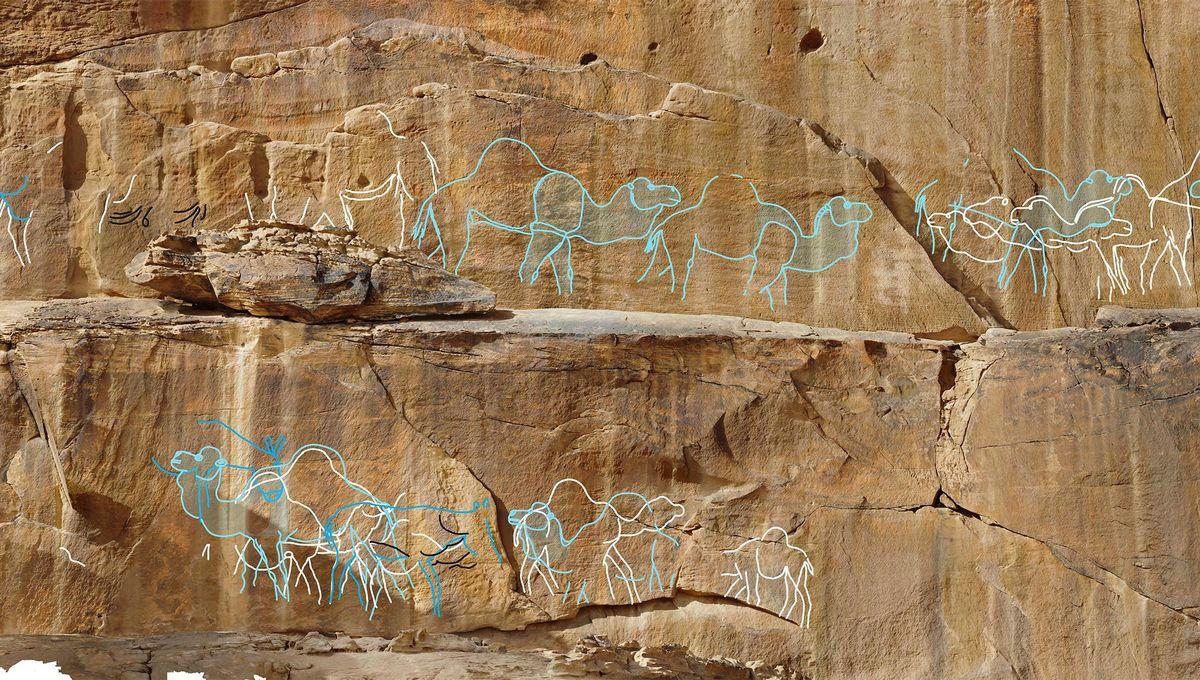-
Новости
- ИССЛЕДОВАТЬ
-
Страницы
-
Статьи пользователей
-
Форумы
At 12,000 Years Old, These Rock Art Masterpieces In The Empty Desert Reveal A Culture Lost To Time

They Thought The Desert Was Empty Around This Time, Then They Found These Monumental Artworks
Physical traces of humans living in the Arabian Desert are scarce between 25,000 to 10,000 years ago. They left few ruins, barely any bones, and only a small scattering of their possessions. However, an incredible display of monumental rock art etched into the desert cliffs reveals that people were here, carving out a rich culture in this harsh desert of red sands.
The rest of this article is behind a paywall. Please sign in or subscribe to access the full content. In the Nefud desert of northern Arabia, dozens of rock walls were scrawled with over 100 life-size engravings of camels, ibex, horses, gazelles, and aurochs. Some of these illustrations are up to 2 metres (6 feet 6 inches) tall, while there are also smaller depictions of humans and more camels. The doodles date to around 12,800 and 11,400 years ago, a period when the region was extremely arid (even more so than usual). Archeological evidence shows that humans inhabited the region over 25,000 years ago, before the end of the last Ice Age ushered in a period of extreme aridity. We also know they were living in the area after 10,000 years, primarily around the oases that sprang up after the dry spell. Yet very little is known about the human cultures that existed here in this broad gap between 10,000 and 25,000 years ago. Rock art with blue lines added to highlight the etchings (left) and the original image of the rock face as it appear today (right). Image credit: Guagnin et al., Nature Communications (2025) In a new study, researchers at the Max Planck Institute of Geoanthropology and University College London have attempted to fill in the gaps by closely studying the rock art of the Nefud Desert. In total, they identified 60 rock art panels containing 176 engravings in three previously unexplored areas – Jebel Arnaan, Jebel Mleiha, and Jebel Misma – along the southern fringes of the desert. Rock art panels at Jebel Arnaan. Tracings highlight the layering of engravings, showing phase 1 in green, phase 2 in yellow, phase 3 in white, and phase 4 in shades of blue. Image credit: Guagnin et al., Nature Communications (2025) They believe it would have taken great care, skill, and dedication to create some of these artworks. One of the murals, for instance, was situated up a rockface that would require the prehistoric artist to climb and work precariously on narrow ledges, teetering high over the desert below. It was only possible to photograph them using aerial drones. Like any prehistoric art, modern minds can only strive to imagine why humans went to such great lengths to produce these engravings, but it suggests the artworks held deep cultural or symbolic significance. After all, in a harsh desert where survival was already a daily struggle, climbing cliffs to etch murals wasn’t a relaxing pastime. Excavation of Trench 1 directly beneath a rock art panel at Jebel Arnaan, where an engraving tool was discovered. Image credit: Sahout Rock Art and Archaeology Project Along with the rock art, the team excavated 532 stone tools, green pigments, and stone beads. It’s unclear whether these artifacts belonged to the same culture that created the grand artworks in the desert, but it could suggest that people living in the region had long-distance connections to other populations much further afield in the Levant region. If so, perhaps these murals were a statement to others, boldly declaring: “We are here. And this is who we are.” Or maybe they served a more practical purpose, acting as markers to guide travelers toward scarce water sources and animal migration routes. “These large engravings are not just rock art – they were probably statements of presence, access, and cultural identity,” Dr Maria Guagnin, lead author from Max Planck Institute of Geoanthropology, said in a statement. “The rock art marks water sources and movement routes, possibly signifying territorial rights and intergenerational memory,” explained Dr Ceri Shipton, co-lead author from the Institute of Archaeology at University College London. The new study is published in the journal Nature Communications.




